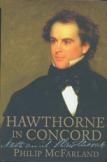The Old Manse and Beyond
On his honeymoon, Nathaniel Hawthorne and his wife, Sophia, read to each other the entirety of Milton’s Paradise Lost, an apt symbol for Hawthorne’s persistent preoccupation with issues of sin, guilt and redemption. To mark the 200th anniversary last summer of Hawthorne’s birth, the historian Philip McFarland has provided a timely re-examination of this author, who was so articulate about the darker side of the American soul.
McFarland seeks to open a fresh perspective on Hawthorne by examining three periods of time between 1842 and 1864, when the author lived in Concord, Mass. Hawthorne was 38 years old and newly married when he moved to Concord, a tranquil county seat of about 1,700 inhabitants that was also home to such luminaries as Thoreau, Emerson, Margaret Fuller and the Alcott family. Hawthorne’s first dwelling in Concord, known as The Old Manse, was a clapboard house that had been constructed by Emerson’s grandfather.
Hawthorne suffered from financial difficulties throughout his life—even The Scarlet Letter earned only $1,500 over a period of about 14 years—and his failure to pay the rent led to his eviction from The Old Manse in 1844. Discouraged, he returned with wife and newborn child to Salem to reside in his mother’s house. After working in the Boston Custom House and then living and writing for a time in Lenox, Hawthorne returned to Concord in 1852 to live in a home called The Wayside.
Hawthorne’s residency in Concord was interrupted again in 1853 by his appointment as consul in Liverpool, England, after which he took his family to Italy for an extended sojourn. Returning to The Wayside in 1860, Hawthorne added to the house a writing studio inspired by a stone tower he had seen in Florence. The Italianate structure afforded him the refuge he needed for his writing, but probably also contributed to his increasing isolation and melancholy.
There is no doubt that Hawthorne drew deep inspiration from the various places where he lived. Born in Salem, Mass., he carried with him the dark legacy of a great-grandfather who had served as a judge in the Salem witchcraft trials. Because his father died when Hawthorne was only 2 years old, he spent most of his youth in rented accommodations, and he also lived for a brief time on Brook Farm, an experiment by the Transcendentalists in communal living.
Although McFarland describes some inspiring moments in Hawthorne’s life during the Concord years (meeting Lincoln, seeing the ironclad Monitor), for all but the most inveterate Hawthorne fan the pleasures of this text are rather too few and far between.
McFarland organizes his book around a straightforward chronological structure (“The Forties,” “The Fifties,” “The Sixties”), but Hawthorne lived in Concord for only about eight of these 30 years. In the decade of the 1850’s, for example, Hawthorne spent only three-and-a-half years in Concord. The gaps of time between the Concord residencies make for a sense of interrupted, fragmentary narrative. It is also unfortunate that the book contains no photos or historical portraits of The Old Manse and The Wayside, or of Concord itself.
R. W. B. Lewis has praised McFar-land’s style as having “an almost Faulknerian intensity,” but this remark suggests another difficulty. With Faulkner one enjoys the sense of mystery, complexity and deferred disclosures, but in a non-fictional literary study the same traits are likely to frustrate the reader. McFarland uses what might best be called a kind of neo-Hawthornesque style, and it often makes for heavy slogging.
In spite of these flaws, McFarland’s book contains some memorable scenes. He recounts what was, from a literary point of view, certainly the most remarkable ice-skating session in American history, with Hawthorne, Emerson and Thoreau gliding together across the frozen, flooded meadows of Concord. Hawthorne’s wife offers a nuanced, if not entirely objective, description: “Henry Thoreau is an experienced skater, and was figuring dithyrambic dances and Bacchic leaps on the ice—very remarkable, but very ugly, methought. Next to him followed Mr. Hawthorne who, wrapped in his cloak, moved like a self-impelled Greek statue, stately and grave. Mr. Emerson closed the line, evidently too weary to hold himself erect, pitching headforemost, half lying on the air.” McFarland’s description of the interactions and cross-fertilization of these great minds in both recreational and intellectual contexts is one of the strengths of the book.
For Catholic readers, it is also interesting that the author who gave us the unforgettable public sinner Hester Prynne in The Scarlet Letter also gave the world a daughter who founded a religious congregation. Hawthorne’s youngest daughter, Rose, converted to Catholicism in 1891 and went on to establish the Dominican Sisters of Hawthorne. She is now on the way to canonization. Truly Hawthorne’s life and imagination seem to have been populated by saints as well as by sinners.
McFarland insightfully characterizes Hawthorne as a forerunner of both modernism, with its highly isolated and alienated heroes, and magic realism, with its romantic celebration of the imagination. He cites Henry James’s astute comparison of Emerson and Hawthorne: “Emerson, as a sort of spiritual sun-worshipper, could have attached but a moderate value to Hawthorne’s cat-like faculty of seeing in the dark.” To the extent that our own time is a spiritually dark age, it certainly seems wise to reacquaint ourselves with the remarkable literary achievement of Hawthorne, in the hope that we might glean some of his gift for seeing in the shadows.
This article also appeared in print, under the headline “The Old Manse and Beyond,” in the February 14, 2005, issue.








